- In short: Hepburn Shire Council’s draft 2024-25 budget reveals a likely $2 million deficit, after $5.5 million in new loans and $1.5 million in operational cuts.
- The outlook shows a need to make $4 million in permanent savings to break even in the following three years.
- What’s next? The Municipal Association of Victoria says many councils are struggling financially and is advocating for the state government to make the rate cap system fairer.
In the beautiful tourist town of Daylesford, it looks like business is booming.
But it’s a different matter at the local council, where officers and councillors are grappling with a budget hit by inflation and cost-of-living pressures.
Hepburn Shire Council says it needs to borrow $5.5 million this year and slash future budgets by $4 million to break even.
$4 million is the equivalent of 20 per cent of the council annual rates income or 12.5 per cent of its cash operating costs.
The Municipal Association of Victoria says Hepburn Shire is not alone in its financial troubles, with serious concerns for the long-term viability of a number of rural councils.
It comes amid a federal government inquiry into local government sustainability and a Victorian government inquiry into local government funding and services.
Money is tight
Hepburn Shire Council Mayor Brian Hood said several years of rate capping below inflation and high inflation generally — particularly in construction costs — was affecting all councils.
He said Hepburn Shire’s relatively low population of 16,500 people spread across five service towns and a large geographical area had amplified its struggles.
The area has also been hit by numerous severe storms in recent years, leaving council $4 million out of pocket, and the council carries the legacy of the mismanagement of a previous major historic building redevelopment, which resulted in a more than $5 million loss.
This is the backdrop to the controversial draft 2024-25 budget, which councillors voted to release for community submissions after a heated debate during a special meeting on Tuesday.
It proposes a $1.5 million cut to operating costs, new borrowings of $5.5 million to complete urgent capital works, a reduction of 16 full-time equivalent staff, less than $300,000 set aside for emergencies and a $2 million deficit.
For many councillors, it’s the outlook for future years that’s even more concerning.
They will have to figure out how to make $4 million in permanent cost savings or bring in more revenue to break even in the following three years.
Applying to the Essential Services Commission for a variation to the rate cap and cutting services are the solutions currently on the table.
They will be considered in more detail when the community is consulted on a 10-year financial plan later this year.
Municipal Association of Victoria (MAV) president David Clark, who is also a Pyrenees Shire councillor, said it had been the toughest lead up to a budget he had seen since the introduction of rate capping in 2016.
“This is now the third year where the rate cap hasn’t been close to the escalation we have seen in costs and wages,” he said.
“Councils have to maintain their services and what they cut is their capital infrastructure.
“That catches up with you sooner or later when your roads can’t be built because you have no money left.”
Future ‘not pretty’
Cr Clark said the MAV was advocating to the state government for a fairer rate cap that moved with local government costs and a simpler pathway to applying for a variation.
He said the organisation was also making a submission into the federal government inquiry into local government sustainability.
“Councils get what is called financial assistance grants every year,” Cr Clark said.
“When they began for councils in the 70s, we got about one per cent of federal taxation.
“That share now is probably closer to 0.6 per cent. To give us our share we need to kick that back up to at least one per cent.
“In local government, for every dollar we get in revenue we have to manage $10 in public assets.
“The state by equivalent manages about $4 [in public assets] and the federal government manages about 40 cents for every dollar.”
Cr Clark said he had serious concerns about the long-term viability of rural councils.
“It is a long slow road until you suddenly run out of money and you have no choices left at all and there is no point amalgamating you with the next door neighbour because they have got no money either,” he said.
“There are some good examples across the world of what the future might look like and the honest answer is, it is not pretty.”
Back in Hepburn Shire, residents will have two weeks to consider the draft budget and make submissions.
A budget must be adopted by June 30.
Get our local newsletter, delivered free each Wednesday
